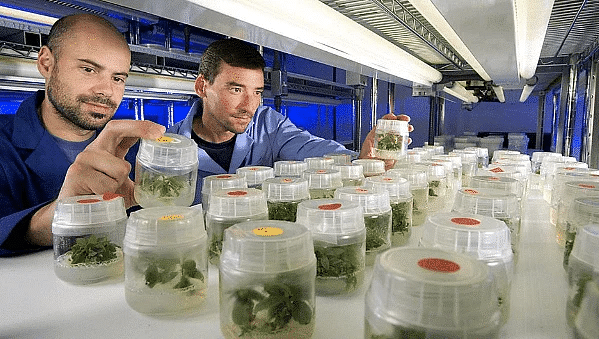Grade 10 Exam > Grade 10 Notes > Biology for Grade 10 > Uses of Plant Hormones
Uses of Plant Hormones | Biology for Grade 10 PDF Download
| Table of contents |

|
| Use of Plant Hormones – Higher |

|
| Uses of Plant Hormones |

|
| Auxins |

|
| Ethene |

|
| Gibberellins |

|
Use of Plant Hormones – Higher
There are many plant hormones, and there are a number of different groups. They are used in agriculture and horticulture to have a specific effect.
Auxins were the first class of plant hormones to be discovered. Their main function is to help plants grow and auxin stimulates plant cells to elongate. The tips of the growing stems and roots (apical meristem) of a plant is one of the main places where auxin is produced. The apical meristem is also the location that all other parts of a plant grow from - the stem, leaves and flowers.
Auxins are one specific group of hormones that are used:
- as weed killers
- as rooting powders
- for promoting growth in tissue culture
Weedkillers
Selective weedkillers kill some plants, but not others. This can be useful for getting rid of dandelions in a lawn without killing the grass or weeds that compete with crops such as wheat. The selective weedkiller contains a growth hormone that causes the weeds to grow too quickly and die. Because most weeds have broader leaves than grass or wheat, the weedkiller is absorbed in larger quantities by the weeds.
Selective weedkillers kill plants that some species of animals rely on as a food source. This can result in a reduction of biodiversity.
Rooting Powder
- Plant cuttings can be dipped in hormone rooting powder before planting.
- Synthetic plant hormones are used to control plant growth. For example, rooting powder contains growth hormones that make stem cuttings develop roots quickly.
Promoting Growth in Tissue Culture
 Scientists with cultured plants
Scientists with cultured plants
- Tissue culture is a technique used to grow whole new plants from small sections of a parent plant.
- Hormones are used to stimulate cell division and elongation.
Uses of Plant Hormones
Higher tier only
- Plant hormones can be extracted or artificially made and used by gardeners and farmers in horticulture and agriculture to usefully control plant growth to obtain larger yields for example
- The use of auxins, ethene and gibberellins commercially has been very beneficial is helping producing food and plants for decoration
- However the everyday use of hormones as weed killers can have a negative effect on biodiversity; as the growth of unwanted but natural plants such as weeds is inhibited
- Many different species of plants are classed as weeds commercially, but to other organisms they are a food source and potential habitat, so destroying them can have negative effects on other organisms in the ecosystem
Auxins
Higher tier only
- Auxins can be used as selective weed killers; negatively affecting the growth of broad-leaved plants which are weeds in comparison to the narrow-leaved grasses and cereals grown as crops for food production (which are desired)
- The growth of weeds is controlled by farmers who don’t want their yields to be smaller as a result of competition between crops and weeds for space and nutrients from the soil
- Selective weedkillers disrupt the growth of weeds only, causing them to die
- However once applied to a crop their spread cannot be controlled, and they could affect other plant species negatively
- If a gardener or farmer wants to easily and cheaply produce lots of clones of a desirable plant, then they can take cuttings of the plant and dip the tips in auxins which are sold as ‘rooting powders’ as they encourage the rapid development of roots
- The same principle as above can be used to clone plants in the lab; auxins in this way are used to promote growth in tissue culture where scrapings of cells can be taken from a desirable plant and used to produce clones in a petri dish that are then planted and allowed to grow in soil
 |
Download the notes
Uses of Plant Hormones
|
Download as PDF |
Download as PDF
Ethene
Higher tier only
- Ethene is used in the food industry to control ripening of fruit during storage and transport
- It is far more effective to transport unripe fruit, as ripe fruit is softer and therefore more easily damaged and spoiled
- The production of ethene can be inhibited to delay ripening of fruits in storage; this can either be achieved directly by adding chemicals that prevent ethene from being produced, or by reacting ethene in the air around fruit with substances that can remove it
- When ripening needs to be encouraged (eg. when fruit is in the supermarket), artificially produced ethene gas can be released to speed up the process
Gibberellins
Higher tier only
- Gibberellins can be used to:
- End seed dormancy, as a high concentration of gibberellin promotes seed germination. Gibberellin levels naturally rise after a period of dormancy (exposure to cold and dry conditions) – usually, dormancy ends with an intake of water into the seed and warmer weather
- Promote flowering regardless of the weather conditions the plant is in
- Increase fruit size – higher levels of gibberellin promote the development and growth of fruit
The document Uses of Plant Hormones | Biology for Grade 10 is a part of the Grade 10 Course Biology for Grade 10.
All you need of Grade 10 at this link: Grade 10
|
110 videos|93 docs|9 tests
|
Related Searches





















